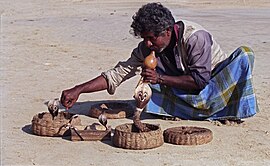Sri Lankan Gypsy people
 Sri Lankan Gypsy Snake Charmer | |
| Total population | |
|---|---|
| c. 4000 | |
| Regions with significant populations | |
| Languages | |
| Sinhala, Telugu, Tamil | |
| Religion | |
| Animism, Buddhism, Hinduism, Christianity | |
| Related ethnic groups | |
| Sinhalese, Sri Lankan Tamils, Telugu people |
Sri Lankan Gypsy people are an ethnic group from Sri Lanka who trace their origins to Telugu-speaking regions centuries ago. They are the only nomadic group of people living on the island. They live in small palmyra huts for two or three days in one place. Their ancestral language is a dialect of Telugu, also known as Sri Lankan Gypsy Telugu. Various governments, NGOs and missionary societies have made attempts to settle them down, and thus some are settled in villages. Amongst the majority Sinhalese speakers they are known as ahikuntaka, while amongst the minority Sri Lankan Tamils and Muslims they are known as Kuravar. However, the use of these terms is considered derogatory and discriminatory, with the group itself identifying simply as Telugus.[1] Some make their living by fortune telling, snake charming and using monkeys and dogs in performances. Those who are settled in resettlement villages are subsistence farmers and farm hands to other farmers. They also speak Sinhalese or Tamil based on their area of settlement. Most seem to be settled in the eastern Batticaloa district. Most follow rudimentary elements of Hinduism, while some are Christians and yet others adhere to Buddhism.[2][3][4][5][6] According to a 2017 survey by the Government of Sri Lanka, their population is ~4,000. Most speak Sinhala, with only a few speaking their ancestral language.[7]
References[]
- ^ "We are Telugu…". The Sunday Times Sri Lanka. Retrieved 2021-09-21.
- ^ "Uplifting the ahikuntaka gypsy community". Dilmah Conservation. Archived from the original on 7 October 2011. Retrieved 12 July 2011.CS1 maint: bot: original URL status unknown (link)
- ^ "By the light of the gypsy fire". 13 February 2011. Retrieved 12 July 2011.
- ^ Subasinghe, Wasantha. "Gypsy Culture and Society in the Changing World: A Sociological Analysis". University of Kelaniya. Retrieved 20 May 2019.
- ^ McGilvray, Dennis (2008). Crucible of Conflict: Tamil and Muslim Society on the East Coast of Sri Lanka. Duke University Press. ISBN 978-0-8223-4161-1.
- ^ Wijesekera, Nandadeva (1965). The people of Ceylon. M.D. Gunasena. p. 53.
- ^ Srinivasan, Meera (2017-12-23). "Beyond the Sinhalese-Tamil ethnic binary". The Hindu. ISSN 0971-751X. Retrieved 2020-07-07.
External links[]
- Telugu people
- Nomadic groups in Eurasia
- Indians in Sri Lanka
- Telugu dialects